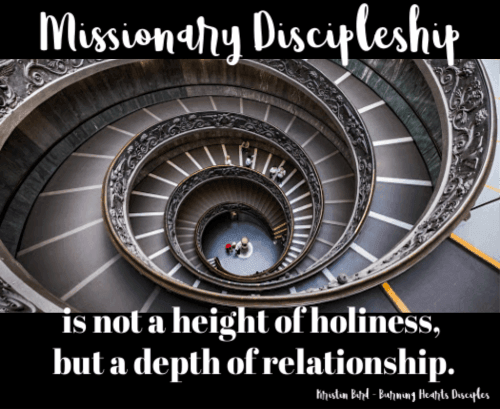The Making Disciples Today Blog has reflections to help you grow in your journey of missionary discipleship, reviews on recommended Catholic evangelization resources, and practical insight on how to evangelize in your daily life.
- Details
- Written by Kristin Bird
The Theology of the Body was the topic of 129 talks given by Saint John Paul II during his Wednesday addresses between September 1979 and November 1984.
The word theology comes from the Greek root words theos (God) and logia (word). Theology, then is literally a “word about God.” St. John Paul II’s Theology of the Body, then, can be described as a word about God and the body.
- Details
- Written by Kristin Bird
The USCCB has outlined a four step methodology for helping people to grow on their discipleship journey. This Encounter, Accompaniment, Community, Mission methodology is outlined in the USCCB document Living as Missionary Disciples: A Resource for Evangelization. While not exhaustive, this resource includes some good reflections on each of the four areas of evangelization methodology.
We have provided some excerpts from the USCCB, some of our own reflections, and additional resources that can help outline what these moments on the discipleship journey might look like - both in your personal life and your parish. Just click on the (+) under each movement.

Encounter
Accompaniment
Community
Mission
-
Encounter
All Christians are invited to a “renewed personal encounter with Jesus Christ” (Evangelii Gaudium, no. 9). -
Accompaniment
The Church will have to initiate everyone—priests, religious and laity—into this ‘art of accompaniment’ which teaches us to remove our sandals before the sacred ground of the other” (cf. Ex 3:5). -
Community
“The faithful are fed by Christ's holy body and blood to grow in the communion of the Holy Spirit (koinonia) and to communicate it to the world.” (CCC, 948). -
Mission
"Evangelizing is in fact the grace and vocation proper to the Church, her deepest identity. She exists in order to evangelize.” Pope Paul VI, Evangelii Nuntiandi, 14
- Details
- Written by Kristin Bird
What does accompaniment look like in the midst of the current crisis of abuse, cover up & scandal? It must mean first LISTENING.

Person to Person Listening: Openness of Heart
We need to provide a space within our hearts for others to feel their despair, hopelessness, anger, betrayal, fear, denial and heartbreak - and then to simply sit with them in that place.
I am struck by how often we (all the Baptized) fall into the trap of trying to tell other people what to feel and how to think about all these matters. What starts as sharing my own emotions quickly turns into debating, posturing, defending, and becoming solution-focused.
When I jump to responding, I ignore the lived experience of the person in front of me. I focus on myself - my own defensiveness, skepticism, anger, etc - rather than being truly present to the other. When I jump to solutions, I am not truly present to brokenness.
We have a particular responsiblity to listen and be truly present to those who have been hurt, traumatized and destroyed by men acting in the name of the Church. It is especially important that we do not allow them to feel forgotten as the spin, politics, and finger pointing continue to make news.
We must pray for those who are still hurting while we argue - but genuine accompaniment calls us to more than prayer. It calls us to compassion, to empathy - to listening - rather than arguing.
Communal Listening: Masses of Healing, Reparation, Atonement, & Repentence
What might this kind of listening look like the context of a larger community - a parish or a diocese?
- Details
- Written by Kristin Bird
September 15 is the Memorial of Our Lady of Sorrows.
May she who followed her Son to Calvary help us to follow him, carrying his cross with serenity and love, to reach the joy of Easter. May the Virgin of Sorrows especially comfort those who are facing the most difficult situations. (Pope Francis, March 24, 2013)
In her role as Our Lady of Sorrows, Mary becomes the mother who cries with us when we are suffering.
When Simeon prohpesied at the temple that a sword would pierce her heart, did she know what that sword would be? Did that prophesy fill her with dread? Did she pray desperately to God to avoid it, even as she taught her young son to seek and obey God's will in his life? As she listened to Jesus cry out on the cross, "My God, My God, why have you forsaken me," (Mt 27:46) did she feel abandoned by God?
 Mary lived in a different time and place. Her experience of daily living was nothing like mine in the details. She didn’t have the convenience of electricity, for one thing. Her vocation was outlined in a very different way.
Mary lived in a different time and place. Her experience of daily living was nothing like mine in the details. She didn’t have the convenience of electricity, for one thing. Her vocation was outlined in a very different way.
And yet, I find that the Mother of God and I do share the humanity of suffering. As she stood at the foot of the Cross, she must have felt the full cascade of emotions and the brunt of sorrow. The three days before Jesus rose must have been torture.
It’s easier to lean back into the arms of someone who’s been there. I look to Mary and see the careworn face of a wife, daughter, and mother who has known the burden of everyday life, the small stings and the big burns. I turn to Mary and I feel the comfort of someone who has survived the suffering and offers me the same graces.
Sarah Reinhard, Integrated Catholic
In her role as the Sorrowful Mother, Mary shows us how - in a life filled with suffering - there is also grace. When we are despondent and feeling hopeless, Our Lady of Sorrows can be a wellspring of hope. She can cry with us in the midst of pain. She can pray with us through our heartbreak. She can wrap us in the comforting warmth of her motherly mantel and just be with us.





